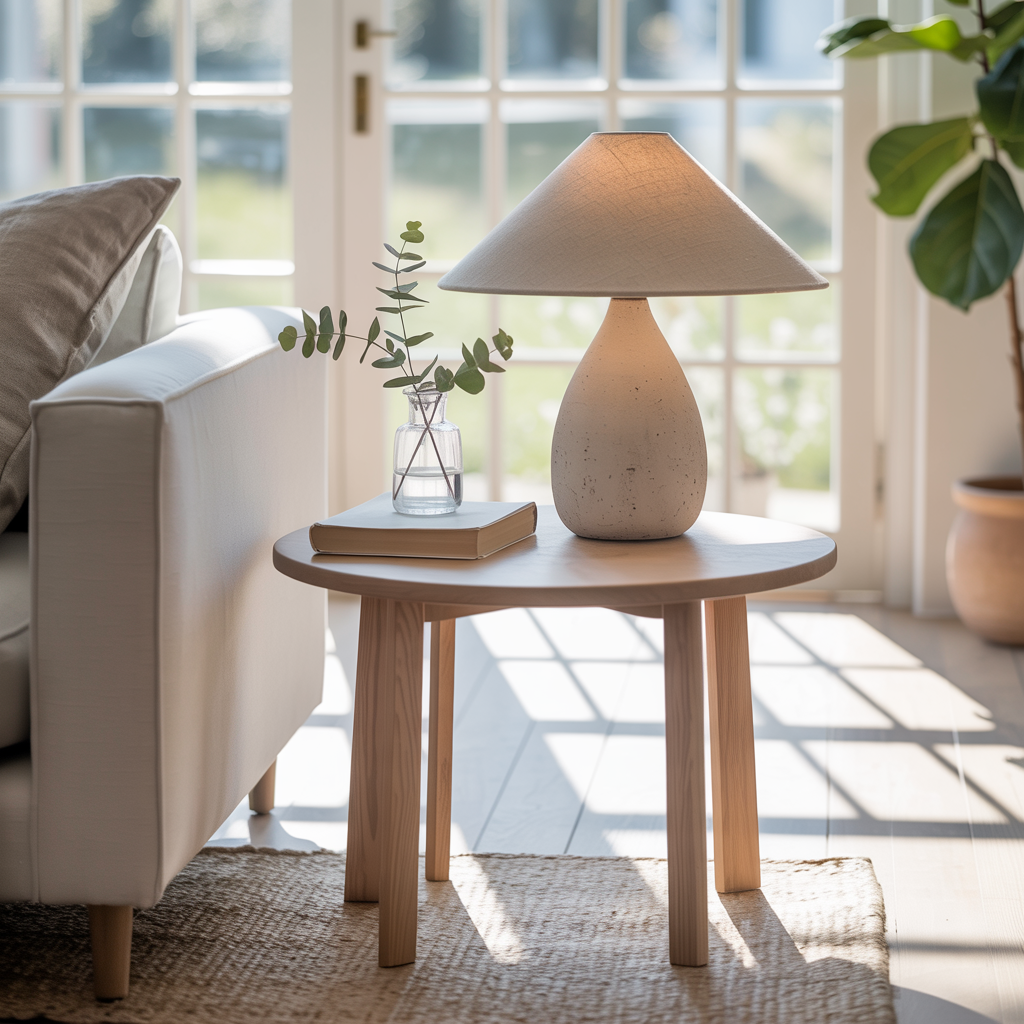End & Side Table Design & Placement Tips
How To Style Side Tables With Lighting, Decor & Accessories
1. Start with the Perfect Base
Before styling, make sure your side table complements your overall furniture composition. The style, height, and material should align with the visual rhythm of your side tables. For modern interiors, slim profiles and clean finishes like wood, metal, or mixed materials are timeless choices. The golden rule: keep the table surface at or just below your sofa’s armrest. This ensures both ergonomic comfort and balanced proportion.
2. Add Lighting for Atmosphere and Function
Lighting sets the mood. A table lamp not only illuminates but also defines the vignette of your side table setup. Choose a lamp scale that matches your furniture height — roughly two-thirds the table’s height. Avoid oversized bases that overwhelm the surface. For contemporary spaces, try a ceramic, wooden, or matte metal lamp. A sculptural silhouette adds height and elegance. When paired with a clean-lined TV stand or entertainment wall, a warm lamp glow softens the overall look, preventing the space from feeling too rigid.
3. Layer with Decorative Objects
A curated mix of objects brings personality to your side table. Think of three key layers: vertical, horizontal, and textural.
- Vertical: A tall lamp, vase, or branch arrangement adds height and anchors the setup.
- Horizontal: A book stack, tray, or ceramic dish grounds the arrangement and adds practicality.
- Textural: Combine matte, glossy, and organic surfaces — like wood grain beside metal or linen beside glass — for richness and balance.
Limit your accessories to a few key pieces. Empty space is equally important — it lets each object breathe.
4. Incorporate Natural Elements
Side tables feel most inviting when they echo nature. Add a small plant, dried stems, or seasonal flowers to introduce freshness and color. These organic accents contrast beautifully against clean lines and metal finishes. If your furniture leans toward warm wood tones, choose greenery with soft leaves or earthy ceramic planters to keep the palette calm and cohesive.
5. Create Balance Across the Room
Styling isn’t just about one table — it’s about the conversation between all pieces. Coordinate both sides of the sofa with different but related arrangements. For example, one side might feature a lamp and plant, while the other displays books and a sculptural object. Pair these details with surrounding furniture like a sleek storage cabinet or open shelving to distribute visual weight throughout the room. Repetition of materials (wood, brass, or black metal) helps the whole space feel unified.
6. Accessorize with Function in Mind
Modern living rooms thrive on a blend of beauty and usability. Incorporate small trays to organize keys or remotes, coasters to protect surfaces, and candles to introduce scent and warmth. Function-forward styling ensures your table remains practical while still visually appealing.
7. Pair with Other Living Room Elements
Your side tables should work in harmony with the rest of your living room. Match or complement your Coffee Table Inspiration & Styling Ideas — consistent color palettes or repeating textures strengthen visual flow. If you have built-in storage or display shelves, reference similar decor objects or lighting temperatures for cohesion. For detailed placement strategies and symmetry principles, explore our guide on End & Side Table Design & Placement Tips.
8. Style for Different Moods & Seasons
Refresh your setup throughout the year. In spring, add fresh blooms and lighter hues. Autumn calls for warm woods, amber glass, and textured fabrics. For winter, layer candles and soft light for comfort. Small swaps can completely transform your space while keeping your base arrangement consistent.
9. Connect Lighting & Storage Harmony
Side table styling becomes more intentional when integrated with your larger lighting and storage plan. A nearby storage cabinet can host additional decor pieces or spare lighting accessories, letting you rotate your styling seasonally. Pairing different light sources — overhead, table, and ambient — creates depth and visual warmth.
10. Achieving a Balanced Modern Aesthetic
The key to styling side tables lies in restraint. Use three to five thoughtfully chosen objects, vary their heights, and maintain balance with negative space. Combine functionality (lamp, tray) with artistry (sculpture, book stack). This balance between utility and style defines modern elegance.
Final Thoughts
When styled with intention, side tables become miniature design moments that enrich your living room’s character. Pair lighting, decor, and accessories strategically — not just for beauty but for everyday ease. Whether next to a sofa, lounge chair, or TV Stands Style, your side table is where form meets function.

